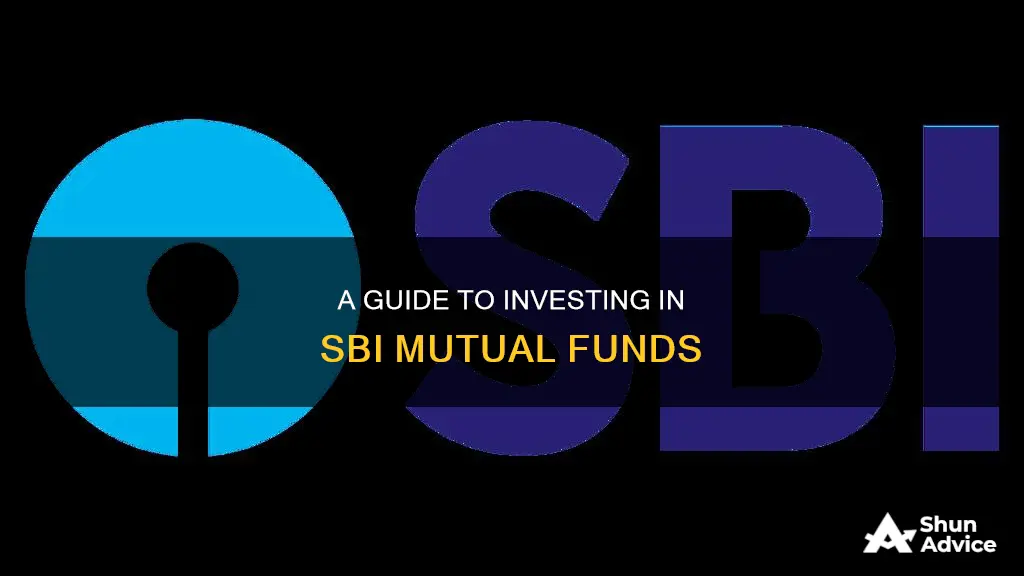
SBI Mutual Fund is one of India's largest and oldest mutual funds. Established in 1987, it is a joint venture between the State Bank of India and Amundi, a French asset management company. The fund offers various investment schemes across equity, debt, hybrid, and other categories. With Rs. 10,24,953.6 crores in assets under management as of June 2024, it holds 16.74% of the industry's AUM. SBI Mutual Fund offers 72 primary schemes, including 37 equity funds, 22 debt schemes, 11 hybrid schemes, and 2 others like gold funds.
There are several ways to invest in SBI Mutual Fund, including through the official website, a distributor, or an online investment platform. The process typically involves registering and creating an account, uploading identification and address proof documents, determining investment duration and risk appetite, selecting the desired scheme, and choosing between a lumpsum or SIP investment.
| Characteristics | Values |
|---|---|
| Established | 29 June 1987 |
| Sponsor | State Bank of India (SBI) |
| Trustee | SBI Mutual Fund Trustee Company Private Limited |
| Registered with SEBI | 23 December 1993 |
| Joint Venture | SBI and AMUNDI Asset Management |
| Number of Primary Schemes | 72 |
| Equity Funds | 37 |
| Debt Schemes | 22 |
| Hybrid Schemes | 11 |
| Other Schemes | 2 |
| Largest Schemes | SBI Nifty 50 ETF, SBI S&P BSE Sensex ETF, and SBI Equity Hybrid Fund |
| Assets Under Management (AUM) | Rs. 10,24,953.6 crores as of June 30, 2024 |
| Investment Methods | Online (official website, distributor, or platform), Offline |
| Minimum Investment | Rs. 1,000 |
What You'll Learn

Online vs. Offline Investment
Investing in mutual funds can be done in two ways: online or offline. Both methods have their own set of advantages and considerations. Here is a detailed comparison to help you decide which approach suits your needs and preferences.
Online Investment
The online mode of investing in mutual funds offers convenience and ease of access. You can invest in mutual funds from the comfort of your home or anywhere with an internet connection. Here are the key steps and considerations for online investment:
- Website Access: You can visit the website of your chosen mutual fund, such as SBI Mutual Fund, and navigate to the investment section. From there, you can explore the available funds and schemes.
- Digital Platforms: Online investment portals, mobile applications, and websites of registrars like CAMS or Karvy provide convenient platforms for investing in mutual funds. These platforms often offer a wide range of fund options and tools to facilitate your investment journey.
- KYC Compliance: As a first-time mutual fund investor, you need to complete Know Your Customer (KYC) formalities. This is a one-time process, and your KYC details can be linked to your Permanent Account Number (PAN) for future investments across different platforms.
- Account Creation: To invest online, you will typically need to create an account with the Mutual Fund House or Asset Management Company (AMC). This involves providing personal and financial information, similar to what you would include in an application form.
- Investment Details: You will need to select the specific fund and investment option (such as growth or dividend) that aligns with your investment objectives. You will also specify the investment type, such as a Systematic Investment Plan (SIP) or lump-sum deposit.
- Payment Methods: Online transactions allow you to complete your investment by making the necessary payments through secure digital methods, such as net banking or credit/debit cards.
Offline Investment
The offline method of investing in mutual funds involves a more traditional, in-person approach. Here are the key steps and considerations for offline investment:
- Physical Forms: Investing offline requires you to physically obtain, fill out, and submit mutual fund application forms. You can get these forms from the offices of the AMC or the point of sale of registrars like CAMS or Karvy.
- Document Submission: In addition to the application form, you will need to provide various documents for in-person verification. These typically include a self-attested copy of your PAN card and address proof, such as a passport copy, utility bill, bank statement, driving license, or rent agreement.
- Cheque or Demand Draft: When submitting your application form and documents, you will also need to provide a cheque or demand draft made in favour of the AMC for the desired investment amount.
- Physical Visits: The offline method necessitates physical visits to the AMC office or local Registrar and Transfer Agent (R&TA) office. These visits allow you to complete the KYC process if you are not already compliant.
- Redemption and SIP Processes: Any subsequent actions, such as redeeming fund units or adjusting your SIP amount, will also require you to physically visit the branch and fill out the necessary forms.
Both online and offline investment methods have their advantages. Online investment offers convenience, saves time, and provides access to a wider range of mutual fund schemes. On the other hand, offline investment may appeal to those who prefer a more traditional, hands-on approach and are more comfortable with physical documentation and in-person interactions. Ultimately, the choice between online and offline investment depends on your personal preferences, technological comfort, and the level of direct involvement you wish to have in the investment process.
Invest in Index Funds: HDFC Securities Guide
You may want to see also

KYC Compliance
To invest money in SBI Mutual Fund, customers must be Mutual Fund KYC compliant. KYC stands for Know Your Customer. This is a set of standards and requirements used in the investment and financial services industries to ensure brokers have sufficient information about their clients, including their risk profiles and financial positions.
CIP requires financial firms to obtain four pieces of identifying information about a client: their name, date of birth, address, and identification number. CDD involves collecting all of a customer's credentials to verify their identity and evaluate their risk profile for suspicious account activity. EDD is used for customers that are at a higher risk of infiltration, terrorism financing, or money laundering, and additional information is collected.
A Beginner's Guide to Investing in Irish Funds
You may want to see also

Short-term vs. Long-term Investment
When it comes to investing in SBI Mutual Funds, there are a variety of options available depending on your financial goals, risk tolerance, and investment timeframe.
The choice between short-term and long-term investment depends on your investment objectives, risk appetite, and time horizon. Here's a detailed comparison to help you understand the differences:
Investment Duration
Short-term mutual funds typically involve investments with durations ranging from a few months to a few years, usually up to 3 years. On the other hand, long-term mutual funds have a longer investment horizon, often spanning several years or even decades.
Risk Profile
Short-term mutual funds are generally considered lower risk as they are less affected by interest rate changes and have lower volatility. They are ideal for investors who want to avoid taking big risks with their money. In contrast, long-term mutual funds carry a higher risk due to their exposure to market volatility. These funds are suitable for investors who are comfortable with taking on more risk and leaving their money invested for an extended period.
Investment Goals
Short-term investments are often chosen by investors with immediate liquidity needs or those seeking quick returns. These investments are suitable for short-term financial goals, such as travel funds, down payments, or emergency funds. On the other hand, long-term investments focus on wealth accumulation over time and are typically chosen for long-term financial goals like retirement planning, buying a home, or funding children's education.
Returns
Short-term mutual funds offer lower expected returns compared to long-term funds. Long-term mutual funds have higher growth potential, but the returns may vary over time. While some years may bring annual returns of over 20%, other years might see returns of 10% or less.
Tax Implications
The tax treatment of short-term and long-term investments differs. For equity funds, investments held for 1 year or less are considered short-term, and profits are taxed as short-term capital gains. Investments held for over a year qualify as long-term, and long-term capital gains tax rates apply. For non-equity investments, such as debt funds, the short-term period is up to 3 years, and different tax rules apply for short-term and long-term capital gains.
Investment Strategies
Short-term investors often choose liquid funds and ultra-short-term debt funds, which offer higher returns than savings accounts. For long-term investments, equity funds such as large-cap funds, diversified equity funds, and equity-linked savings schemes (ELSS) are recommended. Additionally, long-term investors can benefit from the power of compounding, where returns are reinvested, leading to exponential growth over time.
In summary, short-term and long-term investments in SBI Mutual Funds offer distinct benefits tailored to investors' financial goals and timelines. Short-term investments provide lower risk and quicker returns, while long-term investments offer higher growth potential over an extended period, along with the advantage of compounding.
Invest Wisely: Graphene Mutual Funds for Beginners
You may want to see also

Tax Implications
Mutual funds are taxed on capital gains and dividends. Capital gains are the profits generated from selling a capital asset for a higher price than its cost. Dividends are a part of the profits distributed amongst investors by mutual fund houses. The longer you hold on to your mutual fund units, the more tax-efficient they become.
- Equity Funds: These funds invest at least 65% of their money in Indian stocks. Examples include large-cap, mid-cap, and small-cap funds. If you sell after holding for over 12 months, the long-term capital gains (LTCG) tax rate is 12.50%. However, LTCG tax only applies to gains exceeding Rs 1.25 lakh. The tax rate is 20% for short-term capital gains (STCG), which apply when you sell equity funds before 12 months.
- Debt Funds: These schemes invest at least 65% of their money in SEBI-regulated debt instruments. Examples include Liquid Funds and Gilt Funds. For investments made after April 1, 2023, gains are added to your income and taxed at your slab rate, regardless of how long you invest.
- Hybrid Funds: These schemes invest between 35% and 65% of their corpus in Indian equities. Examples include balanced funds and dynamic asset allocation funds. If you sell before July 23, 2024, LTCG (held for more than 36 months) is taxed at 20% with indexation benefit, while STCG will be taxed at the slab rate. If sold on or after July 23, 2024, LTCG (held for more than 24 months) is taxed at 12.50%, while STCG will be taxed at the slab rate.
- ELSS (Equity Linked Savings Scheme): ELSS is a type of mutual fund that allows you to claim an income tax deduction. You can save up to ₹1.5 lakhs per year in taxes by investing in ELSS, which is covered under Section 80C of the Income Tax Act, 1961. ELSS has a lock-in period of 3 years.
Equity Index Funds: A Beginner's Guide to Investing
You may want to see also

SBI Mutual Fund Schemes
SBI Mutual Fund is one of India's largest and oldest mutual funds. It is a joint venture between the State Bank of India and the French asset management company Amundi. The SBI Mutual Fund offers a wide range of tools and investment solutions to help you grow your wealth and meet your investment objectives.
There are more than 40 SBI Mutual Fund Schemes available, including popular funds and new fund offers. The SBI Mutual Fund website provides a Mutual Fund Starter Kit and a range of resources to help new investors understand the basics of mutual funds and start investing.
- Log in to your Groww account or register and create a new one.
- Upload your identification documents, including Aadhaar, PAN, Voter ID card, Passport, Driving License, or any other ID issued by the Central or State government.
- Upload proof of address.
- Determine the duration of your investment.
- Determine the risk amount (high, low, or medium risk).
- Select the best SBI Mutual Fund according to your criteria.
- Decide on the investment type: lumpsum or SIP (Systematic Investment Plan).
- Complete the investment process by either investing a lumpsum amount or starting an SIP.
Some of the specific SBI Mutual Fund schemes include:
- SBI Long Term Equity Fund
- SBI Conservative Hybrid Fund
- SBI Magnum Gilt Fund
- SBI Infrastructure Fund
- SBI Consumption Opportunities Fund
- SBI Healthcare Opportunities Fund
- SBI Nifty Next 50 Index Fund
- SBI Large & Midcap Fund
- SBI Retirement Benefit Fund
- SBI Multi-Asset Allocation Fund
- SBI Banking & Financial Services Fund
- SBI Balanced Advantage Fund
A Beginner's Guide to Exchange-Traded Funds Investing
You may want to see also







